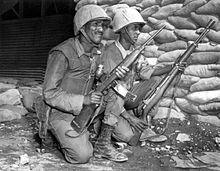Army of the Ethiopian Empire
[1] Emperor Yeshaq I, according to the Islamic historian al-Maqrizi, hired a group of Mamluks led by al-Tabingha to train his army in gunnery and sword fighting.[2] On 9 April 1520, a Portuguese embassy led by Ambassadors Dom Rodrigo de Lima and Mateus, and included missionary Francisco Álvares, arrived in Massawa to negotiate with Emperor Dawit II over the possibility of an alliance against Muslim countries.[3] On 21 February 1543, the Portuguese aided the Ethiopians defeat the Adal Sultanate at the Battle of Wayna Daga ending the fourteen year Ethiopian–Adal war.Due to the instability of the region from the Mahdist invasions the Ethiopians were unable to do anything to prevent the Italian colonization of Eritrea which took access to the Red Sea away from them.In the 1520s Dawit II purchased a small amount of Portuguese and Turkish firearms but large scale usage of them by both lay folk and nobility would not come until after the founding of Gonder.In 1828, Ras Sabagardis, the chief of the Tigray Province, sent his English servant to Bombay, Egypt, and England with requests for firearms and one hundred light cavalry.[12] In his history of Ethiopia, Augustus Wylde wrote: "England made use of King John Emperor Yohannes as long as he was of any service and then threw him over to the tender mercies of Italy...It is one of our worst bits of business out of the many we have been guilty of in Africa...one of the vilest bites of treachery".[5] The Kingdom of Italy attempted to enforce their version of treaty onto the Ethiopians during the First Italo-Ethiopian War, but were defeated due to military support given by the Russian and French through modern weaponry and supplies.Frederick Wilhelm von Syburg, the German ambassador to Ethiopia, attempted to convince the Ethiopians into joining the war through promises of access to the Red Sea, but was unsuccessful.[19] In 1915, Enderase Haile Selassie offered to give the Entente Powers 200,000 soldiers to aid in the defense of Egypt or to participate in the Middle Eastern theatre against the Ottoman Empire.[21] In 1917, Selassie established the Machine Gun Guards under the leadership of Gäbrä Yohannes Woldä Mädhen, who had served in the British army in Kenya as a NCO.[24] In 1928, around 2,000 unemployed German and Austrian men traveled to Ethiopia under the leadership of Herr Wodosch with the promise of receiving three acres of land and a cow after joining the Ethiopian army.[32] Swedish Major General Eric Virgin helped to train Ethiopian infantry and artillery until he was sent back to Sweden on 1 October 1935, two days before the Italian invasion.[22] Nazi Germany gave material support to the Ethiopians with 16,000 rifles, 600 machine guns, 3 airplanes, and 10 million rounds of ammunition as Führer Adolf Hitler wanted the Italians to be weakened before he attempted the Anschluss with the Federal State of Austria.[34][35] Fifty foreign mercenaries joined the Ethiopian forces, including Trinidadian pilot Hubert Julian, an official Swedish military mission under Captain Viking Tamm, the White Russian Feodor Konovalov and the Czechoslovak writer Adolf Parlesak.[38][39] On 3 October 1935, 100,000 soldiers of the Italian Army commanded by Marshal Emilio De Bono attacked from Eritrea without prior declaration of war.[40] The Italians used chemical weapons, in violation of the 1925 Geneva Protocol, effectively against the Ethiopian army, whose uniform consisted of light desert clothing and mostly barefoot soldiers.Shortly before the fall of Addis Ababa to the Italians Haile Selassie had fled from Ethiopia on board the British light cruiser HMS Enterprise (D52).By 1942, the reorganized Ethiopian army was in possession of 250 horses, 2,100 mules, two artillery batteries, an armored car regiment of 205 soldiers, and 148 officers were trained in methods similar to those at the Royal Military College.The Imperial Bodyguard had 3,100 soldiers spread across seven battalions by 1946, and would continue to be the main focus of the Ethiopian army until an attempt coup by the organization against Selassie in 1960.After the Ethiopian-American Mutual Defense Agreement was signed in 1953 the United States sent $3,800,000 worth of small arms, field artillery, and military vehicles to Ethiopia.[46] In 1960, the United States made a secret agreement with Ethiopian to help train and equip an army of 40,000 soldiers to fight against the Somali Republic and rebels in Eritrea.It included a clause stating that if the Allies were unable to find a solution on what to do with the former Italian colonies within a year, the matter would be brought to the United Nations General Assembly.In 1951, three battalions of Ethiopian soldiers were sent, under the leadership of Lieutenant Colonels Täshomä Ergtäu, Asfaw Andargé and Woldä Yohannes Sheta, to aid the South Koreans.




Ethiopian Ground ForcesSt. George's CathedralAddis AbabaBattle of AdwaEmperor of EthiopiaMinister of DefenseAbiye AbebeChief of the General StaffAman AndomAmda Seyon I's ExpansionsEthiopian–Adal warBritish Expedition to AbyssiniaOttoman–Ethiopian border conflictsEthiopian–Egyptian WarMenelik's ExpansionsMahdist WarItalo-Ethiopian War of 1887–1889First Italo-Ethiopian WarSecond Italo-Ethiopian WarWorld War IIKorean WarUnited Nations Operation in the CongoEritrean War of Independence1964 Ethiopian-Somali Border Warland warfare forceEthiopian EmpireYekuno AmlakHaile SelassieOttomansEuropean colonialismChewa regimentsTerritorial evolution of EthiopiaBartolomeu DiascircumventionFasilidesEmperorYeshaq Ial-MaqriziMamluksPortugueseMateusFrancisco ÁlvaresMassawaDawit IIAdal SultanateBattle of Wayna DagaIsma'il PashaEgypt EyaletBerberaMahdist StateGojjamBegemderYohannes IVBattle of GallabatfirearmsGonderTigray ProvinceBombaymatchlocksEast India CompanyHenry John TempleSahle SelassieSebastopolTewodros IIHaile MelekotShewa regionMagdalaCharles Duncan Cameronan armyRobert NapierBattle of MagdalaMenelik IIAlfred IlgWerner MunzingerKhediveKhedivate of EgyptbreechloadersHewett TreatyBeilulQueen VictoriaTreaty of WuchaleKingdom of ItalyNikolay LeontievprotectorateTripartite TreatyFrench SomalilandPort ArthurRusso-Japanese WarGerman EmpireAustria-HungarySerbiaWorld War IEntente PowersWilhelm IICentral PowersLeo FrobeniusMiddle Eastern theatreOttoman EmpireGeorges ClemenceauVittorio Emanuele OrlandoRussian RevolutionRussian EmpireImperial Russian ArmyEast African campaignImperial BodyguardSaint-CyrInterwar periodSoviet UnionFranceRoyal Air ForceAden ProvincePotez 25Junkers W 33cambassador extraordinaryJapanese Armysimilar to the JapaneseAbyssinia Crisisborder skirmishWelwelKellogg–Briand PactItalian Armyair forceCzechoslovakiaSwitzerlandGermanyEric Virgin